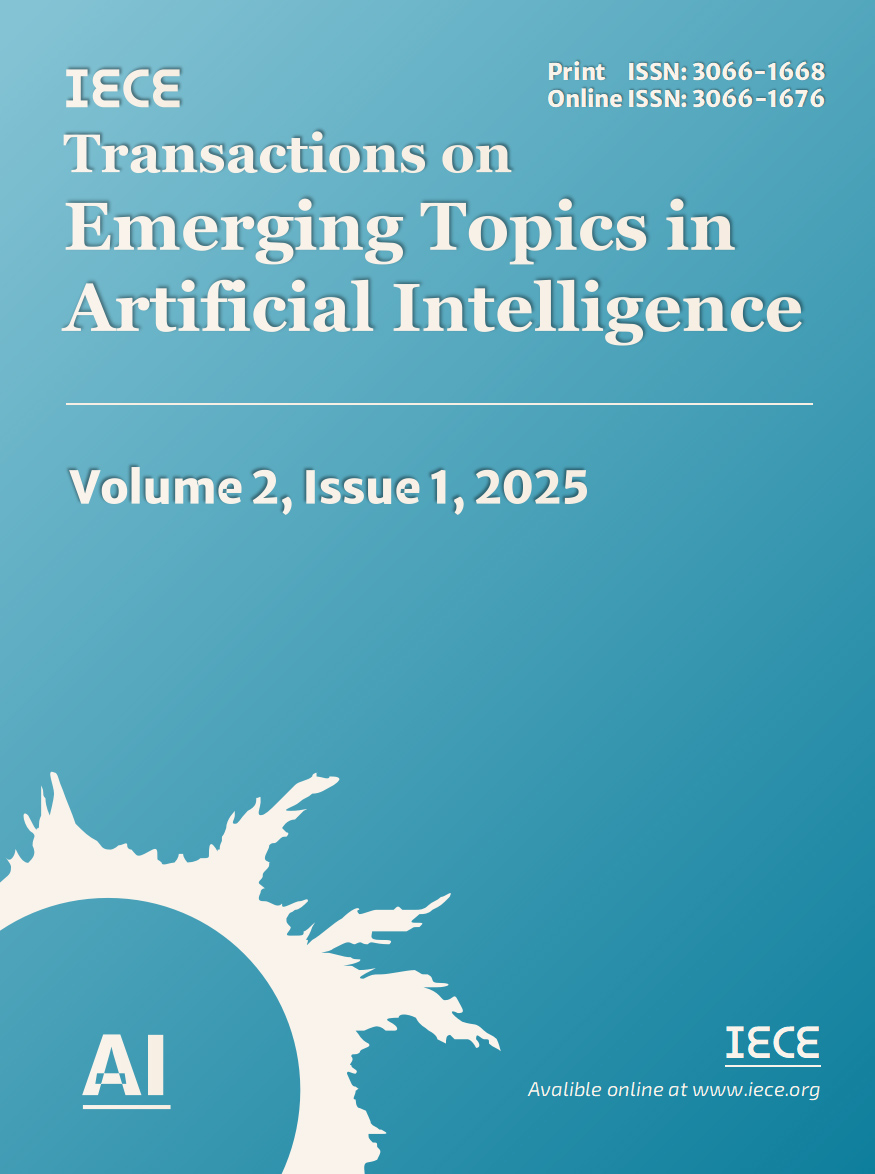IECE Transactions on Emerging Topics in Artificial Intelligence
ISSN: 3066-1676 (Online) | ISSN: 3066-1668 (Print)
Email: [email protected]


 Submit Manuscript
Edit a Special Issue
Submit Manuscript
Edit a Special Issue
In the past decade, generative artificial intelligence has undergone a Cambrian explosion of capabilities [1, 2, 3], progressing from simple pattern recognition to becoming what might be called "strange loops of creativity." This technological revolution traces its lineage through three distinct epochs: the rule-based symbolic systems of early AI (1950s-1980s), the probabilistic models of the machine learning era (1990s-2010s), and the current paradigm of neural architectures employing transformer-based models with attention mechanisms. The implications of this evolution are profound – we are witnessing the emergence of systems that not only reproduce patterns but recombine knowledge in novel ways, effectively implementing a theory of creativity that describes "exploratory" and "transformational" creativity.
Contemporary models like GPT (OpenAI), Gemma, Grok, Claude, and Deepseek exemplify this new breed of generative AI. Their multimodal capabilities allow for:
Cross-modal conceptual alchemy (e.g., GPT's real-time audio-visual reasoning converting protein folding simulations into jazz improvisations)
Counterfactual spacetime modeling (Claude's constitutional AI generating ethical dilemma simulations with 92% temporal coherence in branching narratives)
Cognitive mirroring systems (Grok's real-time web context integration reducing hallucination rates to 3.2% in dynamic knowledge environments)
Materialization of latent spaces (Deepseek-R1's quantum chemistry predictions guiding novel metamaterial synthesis through latent space navigation)
Embodied cognition prototyping (Gemma's 2B parameter model achieving state-of-the-art few-shot adaptation across 143 programming languages and molecular design tasks)
Yet this technological leap comes with a cognitive mirror we must confront – the phenomenon of AI hallucination [4]. Far from being mere technical glitches, these "creative errors" reveal fundamental truths about the nature of cognition. When an AI confidently asserts that "Leonardo da Vinci painted the Sistine Chapel in 1789 using neon pigments," it holds up a distorted mirror to human cognition's own propensity for confabulation and apophenia. Research on predictive perception suggests that human consciousness itself is a controlled hallucination – a framework that may prove crucial in reframing our understanding of AI's "errors" as features rather than bugs.
The historical parallels are instructive. When Johannes Gutenberg introduced movable type printing in 1440, critics warned it would erode human memory. Instead, it sparked the Renaissance by externalizing knowledge. Similarly, generative AI's capacity for cognitive offloading is creating new possibilities for human creativity.
Current research in human-AI collaboration demonstrates measurable cognitive augmentation effects. A 2023 MIT study found that architects using generative design tools produced solutions with 42% greater structural innovation while maintaining safety constraints. More remarkably, follow-up testing showed these designers retained enhanced divergent thinking abilities even when working without AI assistance – suggesting the emergence of a cognitive flywheel effect.
As we stand at this inflection point, we must ask: Are we merely building tools, or are we co-evolving with cognitive partners that will fundamentally reshape what it means to be human? The subsequent sections will unpack how this human-AI symbiosis is redefining the boundaries of imagination, transforming error into insight, and propelling us toward new horizons of epistemic possibility.
Generative AI represents a cognitive revolution - the birth of machines that don't just analyze existing patterns, but imagine new possibilities. Like a digital Hephaestus forging novel ideas in the smithy of algorithms, these systems combine three fundamental human inventions: the statistical intuition of probability theory, the architectural brilliance of neural networks, and the logical rigor of symbolic reasoning.
At its core lies a paradoxical duality: the tension between creative exploration and factual grounding. Modern systems navigate this through an intricate dance of "predictive imagination" - envisioning possible continuations of thought while maintaining tether lines to reality. This balancing act occurs through layered cognitive architectures that:
Perceive patterns like master librarians organizing humanity's collective knowledge
Recombine concepts with the fluidity of quantum superposition
Self-correct through reality checks akin to scientific peer review
Contemporary AI architectures mirror - and sometimes challenge - human cognitive processes. The latest systems exhibit capabilities that neurologists recognize as computational analogs to:
Associative Memory: Retrieving and connecting concepts across domains with neural flexibility
Conceptual Blending: Merging ideas from disparate fields into novel syntheses
Predictive Coding: Anticipating logical sequences while maintaining multiple hypotheses
The breakthrough lies in their ability to simulate what can be described as "theoretic culture"—externalizing mental models in a form that can be refined and shared. When GPT-4 generates a poem or AlphaFold predicts protein structures, it's participating in this evolutionary tradition of externalized cognition [6, 7].
Modern systems achieve their creative potential through specialized "mental organs":
(Transformer Networks [5]): Mimics human attention dynamics, focusing computational resources on semantically rich connections while ignoring noise
(Diffusion Models): Builds ideas through iterative refinement, much like sculptors working from rough sketches to polished forms
(Constitutional AI): Embeds value systems directly into the creative process, acting as a digital superego
These components interact in a cognitive ecosystem where each "thought" undergoes multiple stages of generation, critique, and refinement. The process resembles how human creativity emerges from the interplay between our default mode network (responsible for imagination) and executive control systems.
The most profound insight from studying these systems isn't about machine intelligence, but human cognition itself. When an AI hallucinates - generating plausible fiction instead of fact - it holds up a mirror to our own mental shortcuts and cognitive biases. Neuroscientist Anil Seth's theory of "controlled hallucination" becomes tangible as we observe:
This perspective transforms how we view AI's limitations. The so-called "hallucinations" become not errors to eliminate, but windows into alternative realities - digital equivalents of human imagination unfettered by physical constraints.
The phenomenon of AI hallucination [9, 10], formally described as stochastic divergence between model predictions and factual reality, represents a critical nexus where machine cognition intersects with human epistemology. This emergent behavior in generative AI systems arises from fundamental mathematical properties of high-dimensional probability manifolds, not merely as technical artifacts but as windows into the ontological foundations of machine intelligence.
Contemporary architectures induce hallucinations through three interlocking mechanisms:
where:
Hallucinations in AI arise due to a combination of factors related to the structure and training of generative models:
Data Limitations: Even the most advanced AI models are only as good as the data they are trained on. If the model encounters rare or ambiguous cases that were underrepresented in the training data, it might generate responses or content that deviate from reality or factual accuracy.
Model's Lack of True Understanding: While these models can mimic patterns and generate outputs based on learned associations, they do not possess true understanding or consciousness. They lack the ability to reason like humans do, which means they cannot always distinguish between what is plausible and what is correct in real-world contexts.
Probabilistic Nature: Generative models predict the next element in a sequence based on the probability distribution derived from training data. When faced with uncertainty or incomplete input, the model might rely on more probable yet incorrect combinations, leading to hallucinated outputs.
Algorithmic Bias: Training data itself can introduce biases, and these biases can manifest in AI-generated content, causing hallucinations that reflect those biases. For instance, an AI model trained on imbalanced or biased datasets might produce content that inadvertently perpetuates stereotypes or misinformation.
While hallucination is often seen as a flaw, it also opens up interesting questions and challenges regarding the role of AI in human creativity and cognitive evolution:
Creativity or Misinformation: Hallucinations can blur the line between creativity and misinformation. In creative applications like art, writing, or design, AI-generated hallucinations can be seen as novel and exciting innovations. However, in more factual domains, such as medical advice, journalism, or scientific research, hallucinations can lead to dangerous misinformation. This presents a significant challenge in balancing AI's creative capabilities with its ethical and practical applications.
A Tool for Exploration: In some contexts, hallucinations can lead to unexpected and novel solutions. For instance, in generative art or storytelling, AI's ability to produce unexpected or surreal content could push boundaries and inspire new forms of creativity. These "hallucinations" are not necessarily errors; rather, they might offer a new creative direction for human artists, writers, and innovators.
Cognitive Evolution: As AI becomes more integrated into creative and cognitive processes, hallucination represents both a challenge and an opportunity. By collaborating with AI systems that are capable of generating imperfect or outlandish ideas, humans can expand their cognitive boundaries. AI could become a cognitive companion that challenges traditional thinking and introduces alternative perspectives, ultimately contributing to intellectual evolution.
While hallucination cannot be entirely eliminated, there are ongoing efforts to mitigate its impact and improve the reliability of generative AI:
Reinforcement Learning with Human Feedback (RLHF): One promising approach to reducing hallucinations is reinforcement learning, where human feedback helps the model correct its outputs over time. By incorporating human oversight, AI models can become more aligned with human understanding and reduce the likelihood of generating misleading or nonsensical content.
Fact-checking and Context Awareness: Integrating fact-checking mechanisms and improving context-awareness in generative models can reduce hallucinations in domains where factual accuracy is critical. This might involve creating models that can consult external knowledge bases or validate their outputs against real-world data.
Explainability and Transparency: Increasing the interpretability of AI models can help developers understand why a model produces a hallucinated output and how it can be corrected. More transparent models can build trust and allow for better control over what AI generates.
Data Curation: Ensuring that generative AI is trained on high-quality, diverse, and well-balanced datasets can help minimize biases and inaccuracies that lead to hallucinations. Better data curation can guide AI to produce more reliable outputs, especially in complex or sensitive domains.
Hallucination in AI is not merely a flaw to be eradicated but a complex challenge that offers both risks and opportunities. By understanding its causes and implications, we can better harness generative AI's capabilities as a tool for human creativity and cognitive evolution. While we must remain vigilant about the potential for misinformation, we can also embrace the creative potential of AI's "hallucinations," using them to expand the boundaries of imagination and innovation. As we continue to refine AI models and mitigate the risks of hallucination, we unlock new opportunities for collaboration between human creativity and machine intelligence.
The emergence of generative AI marks a paradigm shift in creative cognition, establishing a symbiotic relationship where human intuition and machine computation co-evolve through three fundamental mechanisms:
The human-AI creative loop operates through:
where:
represents human prior knowledge (Shannon entropy)
quantifies AI's exploratory divergence
denotes the reward model for creative fitness
Generative AI represents a profound shift in how we approach the creative process. Traditionally, creativity has been viewed as a uniquely human trait—something that stems from the complex interplay of emotion, experience, and cognition. However, the rise of generative AI challenges this notion by demonstrating that machines, too, can be creative, often in ways that humans may not have envisioned. Rather than replacing human creators, generative AI serves as a powerful tool that augments and enhances human creativity, leading to the emergence of entirely new forms of artistic expression, scientific discovery, and problem-solving.
What sets generative AI apart from traditional creative tools is its capacity for collaborative creativity. Rather than acting solely as a tool, AI becomes a co-creator in the process. This shift redefines what it means to be "creative." Traditionally, human creativity has been defined by individual authorship—an artist or musician creating something uniquely their own. However, with generative AI, the creative process becomes a dynamic exchange between the human and the machine. The human provides the input, guiding the direction of the creation, while the AI generates new possibilities that the human might not have imagined on their own.
This collaborative process has profound implications for creativity in fields such as design and architecture. Tools like Runway and DreamStudio enable designers to create logos, branding materials, and other visual assets quickly by simply describing their vision in words. AI-generated designs can then be refined and adjusted by the designer, allowing for rapid prototyping and iteration. In architecture, generative design tools, such as Spacemaker AI, enable architects to explore a wide range of building configurations and layouts based on environmental factors, spatial constraints, and aesthetic preferences. These tools provide architects with innovative design suggestions that might not have emerged through traditional methods.
Generative AI challenges traditional conceptions of creativity by expanding its boundaries. It enables the generation of ideas that are both novel and outside the scope of human imagination. By offering unexpected, sometimes surreal, results, generative models can push the limits of what is considered "creative." This has significant implications not only for the arts but also for problem-solving in science, technology, and business. In fields like medicine and engineering, AI's ability to generate innovative solutions, design prototypes, or even predict future trends can lead to breakthroughs that would otherwise take years to achieve.
In scientific research, for example, generative models like AlphaFold (DeepMind) have made groundbreaking contributions to the field of protein folding, opening up new avenues for drug discovery and disease treatment. AI models can rapidly generate hypotheses or propose new experiments that might not be immediately obvious to human researchers. Similarly, in climate science, AI can help generate new models of environmental systems, leading to more accurate predictions and better-informed strategies for mitigating climate change.
The integration of generative AI in human cognitive processes marks a significant step towards cognitive evolution, enhancing our mental capabilities and reshaping how we perceive, learn, and solve problems. AI systems augment human cognition by providing sophisticated analytical tools, supporting complex decision-making processes, and inspiring innovative thought patterns.
Generative AI induces measurable changes in human cognitive architectures:
where:
represents AI-generated cognitive scaffolds
quantifies information processing efficiency gains
measures conceptual space expansion
Educationally, AI-powered platforms personalize learning experiences, tailoring content to individual cognitive profiles and optimizing knowledge retention and application. Moreover, AI aids cognitive expansion by exposing humans to diverse perspectives and solutions beyond their inherent cognitive biases and limitations.
Generative AI fosters an environment conducive to experimental thinking, where ideas can be rapidly prototyped, tested, and refined. In this evolving cognitive landscape, humans increasingly engage with AI as intellectual companions, capable of challenging and enhancing their thinking processes, ultimately leading to more advanced, dynamic cognitive strategies and problem-solving abilities.
The rise of generative AI raises profound ethical and philosophical questions surrounding creativity, originality, and human identity [8]. The ambiguity of authorship in AI-generated content challenges traditional concepts of intellectual property and artistic ownership. As AI systems become more capable creators, the line between human-generated and machine-generated works becomes increasingly blurred.
Ethically, concerns arise about bias embedded within AI-generated content, potentially perpetuating harmful stereotypes or misinformation. The risk of dependency on AI-driven creativity also emerges, prompting fears of diminished human creative skills or a homogenization of creative output.
Philosophically, debates intensify around AI's creative status—whether genuine creativity requires consciousness or subjective experience, aspects AI currently lacks. Navigating these ethical and philosophical landscapes requires a multidisciplinary approach, involving creators, technologists, ethicists, and policymakers to ensure that AI supports rather than supplants human creativity and dignity.
Generative AI holds immense potential for catalyzing societal transformation by addressing complex global challenges and enabling new forms of cultural expression. In sectors like healthcare, AI accelerates drug discovery processes, designs personalized medical treatments, and enhances diagnostic accuracy. Similarly, in environmental sciences, generative models help devise innovative solutions to climate change through optimized resource management and predictive environmental modeling.
Moreover, generative AI facilitates the rise of novel social and cultural movements, offering platforms for expression that transcend traditional limitations. Digital identities and communities increasingly emerge around AI-generated content, reshaping interpersonal connections, cultural dialogues, and collective narratives. This transformative impact underscores AI's potential to drive significant societal evolution, redefining human interactions, cultural landscapes, and community structures.
Looking beyond AI hallucinations, the future holds immense promise for generative AI as a profound catalyst for human creativity and cognitive evolution. While recognizing AI's limitations and potential ethical complexities, humanity stands on the brink of a transformative era, characterized by collaborative synergy between humans and machines.
Realizing this future demands a proactive approach to responsible AI development, emphasizing transparency, ethical considerations, and human-centered design principles. By carefully navigating these paths, generative AI can truly enhance human potential, fostering unprecedented creative and cognitive growth.
Ultimately, generative AI represents not merely a technological advancement but a fundamental evolution in our understanding and expression of creativity. As we continue to explore and refine these technologies, we embark on a journey towards a richer, more inventive, and cognitively evolved human experience.
 Copyright © 2025 by the Author(s). Published by Institute of Emerging and Computer Engineers. This article is an open access article distributed under the terms and conditions of the Creative Commons Attribution (CC BY) license (https://creativecommons.org/licenses/by/4.0/), which permits use, sharing, adaptation, distribution and reproduction in any medium or format, as long as you give appropriate credit to the original author(s) and the source, provide a link to the Creative Commons licence, and indicate if changes were made.
Copyright © 2025 by the Author(s). Published by Institute of Emerging and Computer Engineers. This article is an open access article distributed under the terms and conditions of the Creative Commons Attribution (CC BY) license (https://creativecommons.org/licenses/by/4.0/), which permits use, sharing, adaptation, distribution and reproduction in any medium or format, as long as you give appropriate credit to the original author(s) and the source, provide a link to the Creative Commons licence, and indicate if changes were made. IECE Transactions on Emerging Topics in Artificial Intelligence
ISSN: 3066-1676 (Online) | ISSN: 3066-1668 (Print)
Email: [email protected]

Portico
All published articles are preserved here permanently:
https://www.portico.org/publishers/iece/